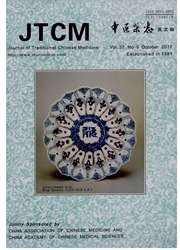

 中文摘要:
中文摘要:
OBJECTIVE: To explore the pathogenesis of dampness syndrome by detecting the changes of interleukin-2 (IL-2) and interleukin-8 (IL-8) levels. METHODS: Female Sprague Dawley rats were divided randomly into five groups according to the random number table: a normal group (GroupⅠ), an external dampness group (GroupⅡ), an internal dampness group (Group Ⅲ), and an external and internal dampness group (GroupⅣ). Twenty days after the model made, IL-2 and IL-8 levels were detected by radioimmunoassay method. RESULTS: The IL-2 and IL-8 levels among groups were significant (F=3.102, P<0.05; F=2.657, P<0.05, respectively). The level of IL-2 in Group Ⅱ and Group Ⅲ were higher than that in GroupⅠ(P<0.05, P<0.01, respectively), especially higher in the Group Ⅲ compared with GroupⅡ (P<0.05). The lev- el of IL-8 in Group Ⅲ were higher than those inGroupⅠ, GroupⅡ and GroupⅣ (P<0.05, P<0.01, P< 0.05, respectively). In the GroupⅢ, the 24-hour wa ter and body weight were higher than that in the GroupⅣ (all P<0.05), and spontaneous movemen frequency was higher than those in GroupⅡ and GroupⅣ (P<0.05). CONCLUSION: Immune activation and inflammato ry reaction might be easily caused by externa danpness other than internal dampness.
 英文摘要:
英文摘要:
OBJECTIVE: To explore the pathogenesis of dampness syndrome by detecting the changes of inter- leukin-2 (IL-2) and interleukin-8 (IL-8) levels. METHODS: Female Sprague Dawley rats were divided randomly into five groups according to the random number table: a normal group (Group Ⅰ ), an external dampness group (Group Ⅱ ), an internal dampness group (Group Ⅲ), and an external and internal dampness group (Group Ⅳ). Twenty days after the model made, IL-2 and IL-8 levels were detected by radioimmunoassay method. RESULTS: The IL-2 and IL-8 levels among groups were significant (F=3.102, P〈0.05; F=2.657, P〈0.05, respectively). The level of IL-2 in Group Ⅱ and Group Ⅲ were higher than that in Group Ⅰ (P〈0.05, P〈0.01, respectively), especially higher in the Group Ⅲ compared with Group Ⅱ (P〈0.05). The level of IL-8 in Group Ⅲ were higher than those in Group Ⅰ, Group Ⅱ and GroupⅣ (P〈0.05, P〈0.01, P〈 0.05, respectively). In the Group Ⅲ, the 24-hour water and body weight were higher than that in the Group Ⅱ (all P〈0.05), and spontaneous movement frequency was higher than those in Group Ⅱ and GroupⅣ (P〈0.05). CONCLUSION: Immune activation and inflammatory reaction might be easily caused by external danpness other than internal dampness.
 同期刊论文项目
同期刊论文项目
 同项目期刊论文
同项目期刊论文
 Study on the Expression of Organic Anion Transporting Polypeptide (oatp2a1) in Rat with Spleen Defic
Study on the Expression of Organic Anion Transporting Polypeptide (oatp2a1) in Rat with Spleen Defic 期刊信息
期刊信息
